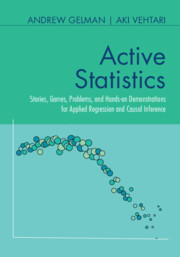Refine search
Actions for selected content:
2348 results in Statistical theory and methods
Chapter 4 - Week by week: the second semester
- from Part 2: - Stories, activities, problems, and demonstrations
-
- Book:
- Active Statistics
- Published online:
- 07 March 2024
- Print publication:
- 14 March 2024, pp 163-318
-
- Chapter
- Export citation
Chapter 2 - Setting up a course of study
- from Part 1: - Organizing a plan of study
-
- Book:
- Active Statistics
- Published online:
- 07 March 2024
- Print publication:
- 14 March 2024, pp 13-28
-
- Chapter
- Export citation
Part 1: - Organizing a plan of study
-
- Book:
- Active Statistics
- Published online:
- 07 March 2024
- Print publication:
- 14 March 2024, pp 1-2
-
- Chapter
- Export citation

Active Statistics
- Stories, Games, Problems, and Hands-on Demonstrations for Applied Regression and Causal Inference
-
- Published online:
- 07 March 2024
- Print publication:
- 14 March 2024
Index
-
- Book:
- Polling at a Crossroads
- Published online:
- 29 February 2024
- Print publication:
- 07 March 2024, pp 267-269
-
- Chapter
- Export citation
2 - The Story of Polling in 21/2 Fiascos
- from Part I - Polling in Context
-
- Book:
- Polling at a Crossroads
- Published online:
- 29 February 2024
- Print publication:
- 07 March 2024, pp 23-46
-
- Chapter
- Export citation
9 - Next-Generation Selection Models
- from Part III - Fighting Nonignorable Nonresponse
-
- Book:
- Polling at a Crossroads
- Published online:
- 29 February 2024
- Print publication:
- 07 March 2024, pp 165-182
-
- Chapter
- Export citation
Contents
-
- Book:
- Polling at a Crossroads
- Published online:
- 29 February 2024
- Print publication:
- 07 March 2024, pp vii-x
-
- Chapter
- Export citation
Dedication
-
- Book:
- Polling at a Crossroads
- Published online:
- 29 February 2024
- Print publication:
- 07 March 2024, pp v-vi
-
- Chapter
- Export citation
14 - Conclusion
- from Part IV - Applications
-
- Book:
- Polling at a Crossroads
- Published online:
- 29 February 2024
- Print publication:
- 07 March 2024, pp 252-252
-
- Chapter
- Export citation
7 - Bounding Damage from Nonignorable Nonresponse
- from Part III - Fighting Nonignorable Nonresponse
-
- Book:
- Polling at a Crossroads
- Published online:
- 29 February 2024
- Print publication:
- 07 March 2024, pp 137-143
-
- Chapter
- Export citation
Figures
-
- Book:
- Polling at a Crossroads
- Published online:
- 29 February 2024
- Print publication:
- 07 March 2024, pp xi-xiv
-
- Chapter
- Export citation
References
-
- Book:
- Polling at a Crossroads
- Published online:
- 29 February 2024
- Print publication:
- 07 March 2024, pp 253-266
-
- Chapter
- Export citation
11 - Putting It Together
- from Part III - Fighting Nonignorable Nonresponse
-
- Book:
- Polling at a Crossroads
- Published online:
- 29 February 2024
- Print publication:
- 07 March 2024, pp 198-210
-
- Chapter
- Export citation
Frontmatter
-
- Book:
- Polling at a Crossroads
- Published online:
- 29 February 2024
- Print publication:
- 07 March 2024, pp i-iv
-
- Chapter
- Export citation
4 - The Wild West of Contemporary Polling
- from Part I - Polling in Context
-
- Book:
- Polling at a Crossroads
- Published online:
- 29 February 2024
- Print publication:
- 07 March 2024, pp 77-98
-
- Chapter
- Export citation
Part I - Polling in Context
-
- Book:
- Polling at a Crossroads
- Published online:
- 29 February 2024
- Print publication:
- 07 March 2024, pp 1-2
-
- Chapter
- Export citation
12 - Nonignorable Nonresponse in Political Surveys
- from Part IV - Applications
-
- Book:
- Polling at a Crossroads
- Published online:
- 29 February 2024
- Print publication:
- 07 March 2024, pp 213-234
-
- Chapter
- Export citation
5 - Nonignorable Nonresponse
- from Part II - A Framework for Modern Polling
-
- Book:
- Polling at a Crossroads
- Published online:
- 29 February 2024
- Print publication:
- 07 March 2024, pp 101-122
-
- Chapter
- Export citation
13 - Nonignorable Nonresponse in Public Health
- from Part IV - Applications
-
- Book:
- Polling at a Crossroads
- Published online:
- 29 February 2024
- Print publication:
- 07 March 2024, pp 235-251
-
- Chapter
- Export citation
